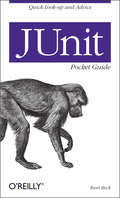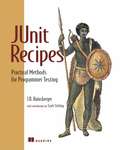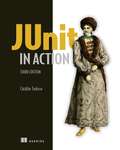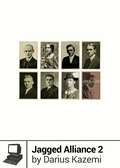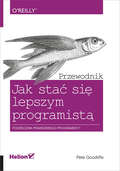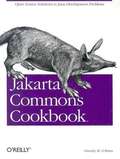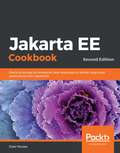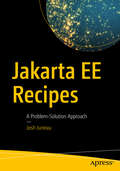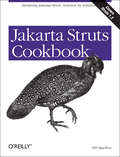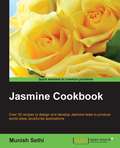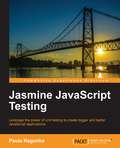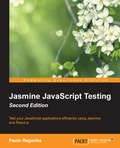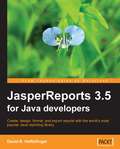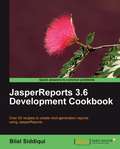- Table View
- List View
JUnit Pocket Guide: Quick Look-up and Advice
by Kent BeckJUnit, created by Kent Beck and Erich Gamma, is an open source framework for test-driven development in any Java-based code. JUnit automates unit testing and reduces the effort required to frequently test code while developing it.While there are lots of bits of documentation all over the place, there isn't a go-to-manual that serves as a quick reference for JUnit. This Pocket Guide meets the need, bringing together all the bits of hard to remember information, syntax, and rules for working with JUnit, as well as delivering the insight and sage advice that can only come from a technology's creator. Any programmer who has written, or is writing, Java Code will find this book valuable. Specifically it will appeal to programmers and developers of any level that use JUnit to do their unit testing in test-driven development under agile methodologies such as Extreme Programming (XP) [another Beck creation].
JUnit Recipes: Practical Methods for Programmer Testing
by Scott Stirling J.B. RainsbergerWhen testing becomes a developer's habit good things tend to happen--good productivity, good code, and good job satisfaction. If you want some of that, there's no better way to start your testing habit, nor to continue feeding it, than with"" JUnit Recipes,"" In this book you will find one hundred and thirty-seven solutions to a range of problems, from simple to complex, selected for you by an experienced developer and master tester. Each recipe follows the same organization giving you the problem and its background before discussing your options in solving it. JUnit - the unit testing framework for Java - is simple to use, but some code can be tricky to test. When you're facing such code you will be glad to have this book. It is a how-to reference full of practical advice on all issues of testing, from how to name your test case classes to how to test complicated J2EE applications. Its valuable advice includes side matters that can have a big payoff, like how to organize your test data or how to manage expensive test resources. What's Inside: - Getting started with JUnit - Recipes for: servlets JSPs EJBs Database code much more- Difficult-to-test designs, and how to fix them - How testing saves time - Choose a JUnit extension: HTMLUnit XMLUnit ServletUnit EasyMock and more!
JUnit in Action
by Catalin TudoseJUnit in Action, Third Edition has been completely rewritten for this release. The book is full of examples that demonstrate JUnit's modern features, including its new architecture; nested, tagged, and dynamic tests; and dependency injection.Summary JUnit is the gold standard for unit testing Java applications. Filled with powerful new features designed to automate software testing, JUnit 5 boosts your productivity and helps avoid debugging nightmares. Whether you're just starting with JUnit or you want to ramp up on the new features, JUnit in Action, Third Edition has you covered. Extensively revised with new code and new chapters, JUnit in Action, Third Edition is an up-to-date guide to smooth software testing. Dozens of hands-on examples illustrate JUnit 5's innovations for dependency injection, nested testing, parameterized tests, and more. Throughout, you&’ll learn how to use JUnit 5 to automate your testing, for a process that consumes less resources, and gives you more time for developing. Purchase of the print book includes a free eBook in PDF, Kindle, and ePub formats from Manning Publications. About the technology The JUnit framework is the gold standard for unit testing Java applications—and knowing it is an essential skill for Java developers. The latest version, JUnit 5, is a total overhaul, now supporting modern Java features like Lambdas and Streams. About the book JUnit in Action, Third Edition has been completely rewritten for this release. The book is full of examples that demonstrate JUnit's modern features, including its new architecture; nested, tagged, and dynamic tests; and dependency injection. You'll benefit from author Catalin Tudose's unique "pyramid" testing strategy, which breaks the testing process into layers and sets you on the path to bug-free code creation. What's inside Migrating from JUnit 4 to 5 Effective test automation Test-driven development and behavior-driven development Using mocks for test isolation Connecting JUnit 5 with Maven or Gradle About the reader For intermediate Java developers. About the author Catalin Tudose has a Ph.D. in Computer Science, and over 15 years of experience as a Senior Java Developer and Technical Team Lead. Previous editions were authored by Petar Tahchiev, Felipe Leme, Gary Gregory, and Vincent Massol. Table of Contents PART 1 - JUNIT 1 JUnit jump-start 2 Exploring core JUnit 3 JUnit architecture 4 Migrating from JUnit 4 to JUnit 5 5 Software testing principles PART 2 - DIFFERENT TESTING STRATEGIES 6 Test quality 7 Coarse-grained testing with stubs 8 Testing with mock objects 9 In-container testing PART 3 - WORKING WITH JUNIT 5 AND OTHER TOOLS 10 Runing JUnit tests from Maven 3 11 Running JUnit tests from Gradle 6 12 JUnit 5 IDE support 13 Coninuous integration with JUnit 5 PART 4 - WORKING WITH MODERN FRAMEWORKS AND JUNIT 5 14 JUnit 5 extension model 15 Presentation-layer testing 16 Testing Spring applications 17 Testing Spring Boot applications 18 Testing a REST API 19 Testing database applications PART 5 - DEVELOPING APPLICATIONS WITH JUNIT 5 20 Test-driven development with JUnit 5 21 Behavior-driven development in JUnit 5 22 Implementing a test pyramid strategy with JUnit 5
JXTATM in a Nutshell
by Li Gong Scott Oaks Bernard TraversatO'Reilly's pioneering reference is the first and last word on this powerful distributed computing technology. JXTA in a Nutshell delivers all the information you need to get started, including an overview of P2P distributed computing, an explanation of the JXTA Project's new platform, and ways that developers can become a part of the development effort. JXTA in a Nutshell introduces major concepts in a hands-on way by explaining them in context to the shell, and contains a complete reference to the JXTA app
Jab, Jab, Jab, Right Hook: How to Tell Your Story in a Noisy Social World
by Gary VaynerchukNew York Times bestselling author and social media expert Gary Vaynerchuk shares hard-won advice on how to connect with customers and beat the competition. A mash-up of the best elements of Crush It! and The Thank You Economy with a fresh spin, Jab, Jab, Jab, Right Hook is a blueprint to social media marketing strategies that really works. When managers and marketers outline their social media strategies, they plan for the “right hook”—their next sale or campaign that’s going to knock out the competition. Even companies committed to jabbing—patiently engaging with customers to build the relationships crucial to successful social media campaigns—want to land the punch that will take down their opponent or their customer’s resistance in one blow. Right hooks convert traffic to sales and easily show results. Except when they don’t.Thanks to massive change and proliferation in social media platforms, the winning combination of jabs and right hooks is different now. Vaynerchuk shows that while communication is still key, context matters more than ever. It’s not just about developing high-quality content, but developing high-quality content perfectly adapted to specific social media platforms and mobile devices—content tailor-made for Facebook, Instagram, Pinterest, Twitter, and Tumblr.
Jack & Jack: You Don't Know Jacks
by Jack Gilinsky Jack JohnsonVine ingenues, YouTube megastars, hip-pop sensations, and best friends Jack & Jack bring their own brand of irreverent comedy, on-point style, and heartfelt life advice to You Don’t Know Jacks. Nebraska natives Jack Gilinsky and Jack Johnson shot to instant fame after their first Vine, “Nerd Vandals,” was dubbed “a perfect Vine” by the Huffington Post. It’s been looped more than ten million times since—and that Vine was just the beginning.Now, after a number one hit on iTunes, nearly two million singles sold, live performances where they have shared the stage with Demi Lovato, Shawn Mendes, and Fifth Harmony, and over 26 million followers across all their social media channels, Jack & Jack are on a wild ride—and they’re not planning to slow down anytime soon. Fans will love reading about their journey from being two regular kids growing up in Omaha, Nebraska, to global superstardom. Complete with never-before-seen photos, behind-the-scenes stories, and hilarious personal anecdotes, You Don’t Know Jacks is an insider look at the lives of Jack & Jack, as told by the guys themselves.
Jagged Alliance 2 (Boss Fight Books)
by Darius KazemiThe turn-based tactical role playing series Jagged Alliance has been sequeled, expanded, modded, optioned, multiplayered, and kickstarted, but the series' many fans usually point to Jagged Alliance 2 as the high water mark, and one of the finest turn-based video games of all time. Jagged Alliance 2 brings to the table a wicked sense of humor, simulation-driven character design, a combination of strategic overworld and tactical battles reminiscent of the X-COM series, and a surprisingly deep open-world RPG experience reminiscent of the Ultima or Elder Scrolls games. Focusing on JA2's development history and basing his book largely on new personal internviews with the game's developers, game designer and web technology developer Darius Kazemi delves deep into the legacy of a game that still has much to teach gamers and game-makers 14 years after its release.
Jailbreak Fire Stick TV Alexa Como desbloquear Guia de dicas passo a passo: Um guia passo a passo sobre como desbloquear dispositivos Amazon Fire Stick
by Hiddenstuff EntertainmentUm guia passo a passo sobre como desbloquear dispositivos Amazon Fire Stick Um guia passo a passo sobre como desbloquear dispositivos Amazon Fire Stick Se não, a melhor característica do Kindle Fire Stick é a capacidade de desbloqueá-los. Isso permitirá que você tenha acesso a qualquer conteúdo que desejar, como programas de TV, aplicativos, músicas e filmes. Aqui está o que você obterá: -Funciona para qualquer Fire Stick -Sobre o Jailbreak -Como fazer o Jailbreak -Resolver problemas -Aproveitar o acesso a aplicativos, filmes, músicas e programas de TV -> Role até o topo da página e clique em adicionar ao carrinho para comprar instantaneamente Isenção de responsabilidade: Este autor e / ou detentores de direitos não fazem reivindicações, promessas ou garantias sobre a precisão, integridade ou adequação do conteúdo deste livro e expressamente se isenta de responsabilidade por erros e omissões no conteúdo nele. Este produto é apenas para referência.
Jak sta? si? lepszym programist?. Przewodnik
by Pete GoodliffePodr?cznik prawdziwego programisty!Zawód programisty jak ?aden inny wymaga ci?g?ego rozwoju, nauki i doskonalenia. Ka?dy dzie? to nowe wyzwania, techniki programistyczne oraz kolejne linie wysokiej jako?ci kodu. Zastanawiasz si?, co jeszcze mo?esz zrobi?, aby sta? si? lepszym programist?? Chcesz zaimponowa? ciekawymi koncepcjami oraz wprowadzi? znacz?ce ulepszenia w codziennej pracy? Trafi?e? na ksi??k?, która sprawi, ?e Twój kod nabierze nowego blasku!Na kolejnych stronach tej ksi??ki przeczytasz o tym, jak powinien by? sformatowany kod ?ród?owy, jakie stosowa? nazewnictwo oraz jak usuwanie zb?dnego kodu wp?ywa na jego jako??. Nauczysz si? odnajdywa? b??dy w kodzie i pisa? dobre testy. Dowiesz si? tak?e, jak w pe?ni korzysta? z mo?liwo?ci systemu kontroli wersji. Ksi??ka ta jest obowi?zkow? lektur? dla ka?dego programisty ceni?cego sobie ci?g?y rozwój, d??enie do doskona?o?ci oraz tworzenie ?wietnego kodu! Techniki z poziomu kodu, dotycz?ce pisania wierszy kodu, testów, debugowania i radzenia sobie ze z?o?ono?ci?. Praktyki, podej?cia i postawy: zachowaj prostot?, wspó?pracuj z innymi, wykorzystuj gotowe rozwi?zania i twórz elastyczny kod. Strategie skutecznego uczenia si?, etycznego post?powania, szukania wyzwa? i unikania stagnacji. Praktyczne metody ko?czenia zada?: u?ywanie w?a?ciwych narz?dzi, ustalanie, jak ma wygl?da? gotowe rozwi?zanie, i szukanie pomocy ze strony wspó?pracowników. Nawyki dobrej wspó?pracy z innymi i traktowania programowania jak zaj?cia spo?ecznego.Obowi?zkowa lektura ka?dego programisty!
Jakarta Commons Cookbook
by Timothy M. O'BrienAs a Java developer, you're always looking for tools to help in your web and application development. Maybe you've heard of the Jakarta Commons open source Java tools. The Jakarta Commons is an open source Jakarta subproject where developers create and maintain a collection of twenty-plus independent Java components and utilities that serve useful purposes. Jakarta Commons packages include utilities for web, XML, networking, building and testing applications, and some that help other packages work better together. Jakarta Commons packages are designed to be reusable. Each one is a time saver by itself, and when used in combination the results can be very powerful. But in searching for information on the Jakarta Commons tools, you find it hard to locate documentation relevant to your needs. You don't have lots of time to spend searching for information on a specific Jakarta Commons tool to determine what it does and how to incorporate it in your code. If you are looking for a single source for clear information and samples on how to use the Jakarta Commons tools, then the Jakarta Commons Cookbook is for you. The Jakarta Commons Cookbook summarizes each of the available Jakarta Commons packages and contains practical and efficient recipes for making the most out of the Jakarta Commons open source Java tools. You don't have to be an expert, since the book explains how and why to use a utility, pitfalls to avoid, and where to look for additional information on Jakarta Commons utilities. It introduces design possibilities and explores combining Jakarta Commons utilities in novel assemblies to create complex applications. The book offers detailed code samples and insider tips--making it a valuable resource whether you are an expert Java developer or a novice. If you want to quickly learn how to use Jakarta Commons timing-saving utilities or have an invaluable resource for Jakarta Commons questions and techniques, then the Jakarta Commons Cookbook is for you.
Jakarta EE Cookbook: Practical recipes for enterprise Java developers to deliver large scale applications with Jakarta EE, 2nd Edition
by Elder MoraesAn enterprise Java developer's guide to learning JAX-RS, context and dependency injection, JavaServer Faces (JSF), and microservices with Eclipse MicroProfile using the latest features of Jakarta EE Key Features Explore Jakarta EE's latest features and API specifications and discover their benefits Build and deploy microservices using Jakarta EE 8 and Eclipse MicroProfile Build robust RESTful web services for various enterprise scenarios using the JAX-RS, JSON-P, and JSON-B APIs Book Description Jakarta EE is widely used around the world for developing enterprise applications for a variety of domains. With this book, Java professionals will be able to enhance their skills to deliver powerful enterprise solutions using practical recipes. This second edition of the Jakarta EE Cookbook takes you through the improvements introduced in its latest version and helps you get hands-on with its significant APIs and features used for server-side development. You'll use Jakarta EE for creating RESTful web services and web applications with the JAX-RS, JSON-P, and JSON-B APIs and learn how you can improve the security of your enterprise solutions. Not only will you learn how to use the most important servers on the market, but you'll also learn to make the best of what they have to offer for your project. From an architectural point of view, this Jakarta book covers microservices, cloud computing, and containers. It allows you to explore all the tools for building reactive applications using Jakarta EE and core Java features such as lambdas. Finally, you'll discover how professionals can improve their projects by engaging with and contributing to the community. By the end of this book, you'll have become proficient in developing and deploying enterprise applications using Jakarta EE. What you will learn Work with Jakarta EE's most commonly used APIs and features for server-side development Enable fast and secure communication in web applications with the help of HTTP2 Build enterprise applications with reusable components Break down monoliths into microservices using Jakarta EE and Eclipse MicroProfile Improve your enterprise applications with multithreading and concurrency Run applications in the cloud with the help of containers Get to grips with continuous delivery and deployment for shipping your applications effectively Who this book is for This book is for Java EE developers who want to build enterprise applications or update their legacy apps with Jakarta EE's latest features and specifications. Some experience of working with Java EE and knowledge of web and cloud computing will assist with understanding the concepts covered in this book.
Jakarta EE Recipes: A Problem-Solution Approach
by Josh JuneauTake a problem-solution approach to programming enterprise Java applications and microservices for cloud-based solutions, enterprise database applications, and even small business web applications. This book provides effective and proven code snippets that you can immediately use to accomplish just about any task that you may encounter. You can feel confident using the reliable solutions that are demonstrated in this book in your personal or corporate environment.Java EE was made open source under the Eclipse Foundation, and Jakarta EE is the new name for what used to be termed the Java Enterprise Edition Platform. This book helps you rejuvenate your Java expertise and put the platform’s latest capabilities to use in quickly developing robust applications. If you are new to Jakarta EE, this book will help you learn features of the platform, and benefit from one of the most widely used and powerful technologies available for application development today. Examples in Jakarta EE Recipes highlight Jakarta EE’s capabilities, helping you to build streamlined and reliable applications using the latest in Java technologies. The book takes a problem-solution approach in which each section introduces a common programming problem, showing you how to best solve that problem using the latest features in Jakarta EE. Solutions are presented in the form of working code examples that you can download and use immediately in your own projects. Clear descriptions are given so you can understand and learn to build further on the solutions that are provided. This is the ideal book for the code-focused programmer interested in keeping up with the future of enterprise development on the Java Platform. What You Will LearnDevelop enterprise Java applications using the now open source Jakarta EE platformCreate great-looking user interfaces using Jakarta Server Faces and the Eclipse Krazo frameworkBuild database applications using Jakarta Enterprise Beans and Jakarta RESTFul web servicesAutomate testing through cohesive test suites built on Arquillian for Jakarta EE applicationsDeploy microservices applications in cloud environments using DockerSecure applications utilizing the Jakarta EE Security API and JSON Web Tokens Who This Book Is ForJava developers interested in quickly finding effective and proven solutions without reading through a lengthy manual and scrubbing for techniques
Jakarta Struts Cookbook
by Bill SiggelkowThe Jakarta Struts Framework is a popular open source platform for building web applications from top to bottom with Java. While this popularity has led to a wealth of online and in-print documentation, developers still find themselves faced with a number of common tasks that are not clearly and succinctly explained. In these situations, programmers can now turn to the Jakarta Struts Cookbook an amazing collection of code solutions to common--and uncommon--problems encountered when working with the Struts Framework. Among many other recipes, this book explains how to: display data in complex HTML tables use JSP, the JSTL, and JavaScript in your user interface define static and dynamic action forms validate data and respond to errors use Logging, Validation, and Exception Handling integrate Struts with persistence frameworks like Hibernate and iBATIS This look-up reference is just what today's time-pressed developers need. With solutions to real-world problems just a few page flips away, information is instantly available. And while the book's solutions focus on getting to the point, each recipe's discussion section imparts valuable concept and insight from a Struts veteran. The Jakarta Struts Cookbook is perfect for independent developers, large development teams, and everyone in between who wishes to use the Struts Framework to its fullest potential. Plus, it s completely up-to-date with the latest versions of Framework, so readers can be sure the information is viable.
James Acaster's Guide to Quitting Social Media
by James AcasterThis is a self help book like no other. Because you are not helping yourself, James Acaster is helping you.When James quit all forms of social media in 2019 he felt like he'd been born anew, but he was worried he'd suffer withdrawal and get lured back online to compete in a never ending popularity contest with only one possible winner (f*cking Zuckerberg). He knew that in order to stay clean he'd have to replace everything social media used to give him with three-dimensional, real-life activities. And so it was that James found ways to anonymously bully strangers, see photos of everyone's dogs, get invited to as many parties as possible, immediately know about all celebrity deaths, get public figures fired, argue with everybody about everything, and so much more without even owning a phone (he painted over the screen of his old one to stop himself looking at Instagram). His life is amazing and yours could be too if you buy JAMES ACASTER'S GUIDE TO QUITTING SOCIAL MEDIA, BEING THE BEST YOU YOU CAN BE AND SAVING YOURSELF FROM LONELINESS VOL. 1. You will also need to do everything the audiobook tells you to. Including helping us promote the audiobook by tweeting about it.(P) 2022 Headline Publishing Group Ltd
James Acaster's Guide to Quitting Social Media
by James AcasterThis is a self-help book like no other. Because you are not helping yourself, James Acaster is helping you.In 2019, James quit all forms of social media - covering his phone in tar and driving it to a lock-up in Rhyl, before setting up home in a castle he'd built himself called Castle Anti-Net. But when the withdrawal symptoms hit him, he realised in order to stay clean he'd have to replace everything social media gave him with three-dimensional, real-life activities. Employing the help of a mysterious, wealthy benefactor named Clancy Dellahue, and an ever-growing gang of misfits (aka the Tangfastic Crew), James found ways to replace his online friends (he joined the scouts) and spy on his exes (climbing ropes, zip lines, fake moustache) as well as anonymously bullying strangers, seeing photos of everyone's dogs, getting public figures fired, arguing with everybody about everything, and so much more. His life is amazing and yours could be too if you buy JAMES ACASTER'S GUIDE TO QUITTING SOCIAL MEDIA, BEING THE BEST YOU YOU CAN BE AND SAVING YOURSELF FROM LONELINESS VOL. 1.
James Acaster's Guide to Quitting Social Media
by James AcasterThis is a self-help book like no other. Because you are not helping yourself, James Acaster is helping you.In 2019, James quit all forms of social media - covering his phone in tar and driving it to a lock-up in Rhyl, before setting up home in a castle he'd built himself called Castle Anti-Net. But when the withdrawal symptoms hit him, he realised in order to stay clean he'd have to replace everything social media gave him with three-dimensional, real-life activities. Employing the help of a mysterious, wealthy benefactor named Clancy Dellahue, and an ever-growing gang of misfits (aka the Tangfastic Crew), James found ways to replace his online friends (he joined the scouts) and spy on his exes (climbing ropes, zip lines, fake moustache) as well as anonymously bullying strangers, seeing photos of everyone's dogs, getting public figures fired, arguing with everybody about everything, and so much more. His life is amazing and yours could be too if you buy JAMES ACASTER'S GUIDE TO QUITTING SOCIAL MEDIA, BEING THE BEST YOU YOU CAN BE AND SAVING YOURSELF FROM LONELINESS VOL. 1.
Jane Eyre on Social Media: The perfect gift for Brontë fans
by Sarah Day Claire McGowanReader, she married him. But not before a LOT of discussion of his behaviour in the group chat.With courage, determination and logged into her social media accounts - plain Jane Eyre is ready to take on the world. But then she meets and begins to fall for Edward Rochester, AKA the definition of a red flag, with screenshots to prove it.When authors Claire McGowan and Sarah Day imagined how 'Pride and Prejudice on Social Media' might look, retelling the story through mocked-up social media posts, their post instantly went viral. Now, they return with a Bronte classic told through highs and lows of social media . . .Perfect for fans of Charlotte Brontë . . .
Jane Eyre on Social Media: The perfect gift for Brontë fans
by Sarah Day Claire McGowanSarah Day and Claire McGowan retell Jane Eyre for the modern-day social media world: Reader, she married him. But not before a LOT of discussion of his behaviour in the group chat.With courage, determination and logged into her social media accounts - plain Jane Eyre is ready to take on the world. But then she meets and begins to fall for Edward Rochester, AKA the definition of a red flag, with screenshots to prove it.When authors Claire McGowan and Sarah Day imagined how 'Pride and Prejudice on Social Media' might look, retelling the story through mocked-up social media posts, their post instantly went viral. Now, they return with a Bronte classic told through highs and lows of social media . . .Perfect for fans of Charlotte Brontë . . .(P)2023 Hodder & Stoughton Limited
Jane Eyre on Social Media: The perfect gift for Brontë fans
by Sarah Day Claire McGowanReader, she married him. But not before a LOT of discussion of his behaviour in the group chat.With courage, determination and logged into her social media accounts - plain Jane Eyre is ready to take on the world. But then she meets and begins to fall for Edward Rochester, AKA the definition of a red flag, with screenshots to prove it.When authors Claire McGowan and Sarah Day imagined how 'Pride and Prejudice on Social Media' might look, retelling the story through mocked-up social media posts, their post instantly went viral. Now, they return with a Bronte classic told through highs and lows of social media . . .Perfect for fans of Charlotte Brontë . . .***READERS LOVE JANE EYRE ON SOCIAL MEDIA***'This is a fun text with a witty comedic spin and definitely one to put on your TBR pile' ⭐⭐⭐⭐⭐ 'If you read nothing else this year, read this! It's honestly the best read of the year. Not only is it a clever idea for a retelling, it's charming, witty and downright hilarious!' ⭐⭐⭐⭐⭐ 'It all did make me laugh. Lots!' ⭐⭐⭐⭐⭐ 'Really well done and difficult to put down. I see the authors have done the same thing with Pride and Prejudice and I am definitely adding that to my TBR' ⭐⭐⭐⭐ 'What a funny and quirky book!' ⭐⭐⭐⭐ 'This clever retelling combines charm, wit, and humour to create an engaging and hilarious narrative' ⭐⭐⭐⭐ 'A lot of fun and a good way to make modern a classic' ⭐⭐⭐⭐
Japanese Culture Through Videogames (Routledge Contemporary Japan Series)
by Rachael HutchinsonExamining a wide range of Japanese videogames, including arcade fighting games, PC-based strategy games and console JRPGs, this book assesses their cultural significance and shows how gameplay and context can be analyzed together to understand videogames as a dynamic mode of artistic expression. Well-known titles such as Final Fantasy, Metal Gear Solid, Street Fighter and Katamari Damacy are evaluated in detail, showing how ideology and critique are conveyed through game narrative and character design as well as user interface, cabinet art, and peripherals. This book also considers how ‘Japan’ has been packaged for domestic and overseas consumers, and how Japanese designers have used the medium to express ideas about home and nation, nuclear energy, war and historical memory, social breakdown and bioethics. Placing each title in its historical context, Hutchinson ultimately shows that videogames are a relatively recent but significant site where cultural identity is played out in modern Japan. Comparing Japanese videogames with their American counterparts, as well as other media forms, such as film, manga and anime, Japanese Culture Through Videogames will be useful to students and scholars of Japanese culture and society, as well as Game Studies, Media Studies and Japanese Studies more generally.
Jasmine Cookbook
by Munish SethiIf you are a competent JavaScript developer who wants to design and implement tests using Jasmine in order to minimize bugs in the production environment, then this book is ideal for you. Some familiarity with unit testing and code coverage concepts such as branch coverage along with basic knowledge of Node.js, AngularJS, and CoffeeScript is required.
Jasmine JavaScript Testing
by Paulo RagonhaThe book uses a concise, to-the-point approach to help developers understand and use the power of Jasmine to create better and more maintainable codebases.This book is a must-have guide for web developers who are new to the concept of unit testing. It's assumed that you have a basic knowledge of JavaScript and HTML.
Jasmine JavaScript Testing - Second Edition
by Paulo RagonhaThis book is for web developers and designers who work with React.js and JavaScript and who are new to unit testing and automation. It's assumed that you have a basic knowledge of JavaScript and HTML.
JasperReports 3.5 for Java Developers
by David R. HeffelfingerThis book is a comprehensive and practical guide aimed at getting the results you want as quickly as possible. The chapters gradually build up your skills and by the end of the book you will be confident enough to design powerful reports. Each concept is clearly illustrated with diagrams and screen shots and easy-to-understand code. If you are a Java developer who wants to create rich reports for either the Web or print, and wants to get started quickly with JasperReports to do this, this book is for you. No knowledge of JasperReports is presumed.
JasperReports 3.6 Development Cookbook
by Bilal SiddiquiThe entire book is a comprehensive collection of recipes meant to tutor you on making and enhancing reports. Each recipe provides you with easy step-by-step descriptions of the actions necessary to accomplish a specific task with explanations to help you to understand how and why each action was undertaken. Example values and code samples are used throughout the recipes, which makes adaptation for individual needs easy. Each recipe uses a concrete example for easy understanding. This book is for Java developers who want to use JasperReports to create user-friendly business reports. It is for those who may be familiar with JasperReports but want to dive into advanced JasperReports activities. If you know how to use Microsoft Word you can also learn how to design business reports using iReport by following the recipes of this cookbook. Although the primary audience of this cookbook are report designers, however Java and XML developers will find this book useful in understanding how Jasper's XML code works and how to wrap JasperReports functionality in your Java Swing or Web applications.
